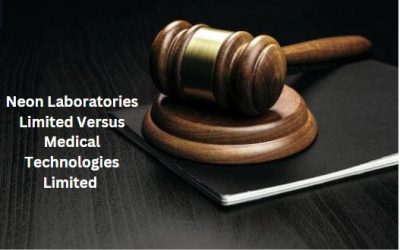Parties
The Respondent-Plaintiffs are indulged in the manufacturing and marketing of pharmaceutical products and became the owner of the trademark ‘PROFOL’ in the year 2000 after amalgamating with the predecessor-in-title, Hematal Biologicals Ltd. or Core Health Care Ltd. who had applied for registration of the trademark ‘PROFOL’ in the year 1998 and received the registration of the trademark in the same year.
The Appellant-Defendants are the owners of the trademark ‘ROFOL’. They applied for registration of their trademark on 19 October, 1992 and received the registration of the same on 14 September, 2001.
Brief Facts
Brief facts of the case are as follows:
The Respondent-Plaintiffs became the owner of the trademark ‘PROFOL’ upon amalgamation with their predecessor-in-title, Hematal Biologicals Ltd. or Core Health Care Ltd. in the year 2000.
Their predecessor-in-title invented the trademark ‘PROFOL’ in the year 1998.
Subsequent to the amalgamation with the predecessor-in-title, the Respondent-Plaintiffs applied for registration of the trademark ‘PROFOL’ in the year 2000 and have since been using the trademark.
On the other hand, the Appellant-Defendants received the registration of their trademark ‘ROFOL’ in the year 2001. However, they contend that their application for registration dates as far back as 1992.
The Appellant-Defendants did not start marketing their products under the trademark ‘ROFOL’ until 2004.
Upon learning that the Appellant-Defendants have been placing their products in the market under their trademark ‘ROFOL’, the Respondent-Plaintiffs filed a suit on 17 July, 2005 asserting that the trademark ‘ROFOL’ is deceptively similar to their trademark ‘PROFOL’.
Issues
Whether there is a prima facie case in favour of the Respondent-Plaintiffs?
Whether the balance of convenience lies in favour of the Respondent-Plaintiffs?
Whether the Respondent-Plaintiffs will suffer irreparable loss or damage if an injunction is not granted?
Applicable Rules
Section 34 of the Trademarks Act, 1999;
Section 47 of the Trademarks Act, 1999;
Arguments on behalf of Appellant-Defendants:
The Appellant-Defendants argue that they had filed the application for registration of their trademark on 19.10.1992 long before the Respondent-Plaintiffs had any presence in the market.
Arguments on behalf of Respondent-Plaintiffs:
The Respondent-Plaintiffs argue that their user commenced prior to that of the Appellant-Defendants as their predecessor-in-title initiated the use of the trademark ‘PROFOL’ in the year 1998 whereas the user of the Appellant-Defendants’ trademark commenced from 16 October, 2004 onwards.
Ratio
The Hon’ble Supreme Court opined that the user of the Appellant-Defendants remained dormant for 12 years. Meanwhile, the Respondent-Plaintiffs got their trademark ‘PROFOL’ registered, commenced the production and marketing of products under their trademark ‘PROFOL’ and built goodwill in the market.
The Apex Court placed reliance on Section 47 of the Trademarks Act, 1999 which postulates that a registered trademark may be taken off the register in case there is no bona fide use of the trademark for a continuous period of 5 years and 3 months from the date on which the trademark was registered.
The Appellant-Defendants did not use their trademark for several years. The Apex Court was of the view that the Appellant-Defendants’ reluctance in protecting their trademark was “legally lethargic” and insinuates that they had abandoned their trademark at some point during the period of 12 years between 1992 to 2004. The legislative intent behind section 47 is to prevent hoarding of trademarks in case of non-utilisation. The applicant of a trademark does not have a permanent right over their trademark. Such a right is lost if it is not exercised within a reasonable time.
The Hon’ble Supreme Court also analysed Section 34 of the Trade Marks Act, 1999 and emphasized on the importance of the “first user” rule. Section 34 states that the proprietor or the registered user of a trademark cannot restrain the use by another party having an identical or deceptively similar mark if:
The use of their trademark commenced prior to that of the proprietor or the registered user or,
The date of registration of their trademark is prior to the date of registration of the proprietor’s or the registered user’s trademark.
The Apex Court expressed that since the Appellant-Defendants had filed an application for registration of their trademark ‘ROFOL’ in the year 1992, much before the user of the Respondent-Plaintiffs commenced, they had the opportunity of restraining the Respondent-Plaintiffs from using a similar mark but no action whatsoever was taken by the Appellant-Defendants in initiating any litigation against the Respondent-Plaintiffs or placing their own products in the market.
The Apex Court relied on the cases of N.R. Dongre v. Whirlpool Corpn. (1996) and Milmet Oftho Industries v. Allergan Inc. (2004) wherein the Apex Court had granted an interim injunction in favour of the prior user. The Apex Court also placed reliance on the judgment of S. Syed Mohiden v. P. Sulochana Bai (2016) wherein it was held that the rights of a prior user will take precedence over the rights of a subsequent user even if they have received registration of their trademark.
The Apex Court then deliberated on the question as to whether the prior user of the trademark would mean prior to the date of application or prior to the user by Appellant-Defendants. The Hon’ble Supreme Court reached a conclusion that since the Respondent-Plaintiffs have been using their trademark long before the user by Appellant-Defendants, a prima facie case lies in their favour. Furthermore, the Hon’ble Supreme Court held that the balance of convenience lies in favour of the Respondent-Plaintiffs and an irreparable loss or damage will be caused to them if the injunction is denied.
The Apex Court affirmed the decision of the trial court and held that the Respondent-Plaintiffs are entitled to temporary injunction.
Author: Sonakshi Pandey, in case of any queries please contact/write back to us via email to chhavi@khuranaandkhurana.com or at Khurana & Khurana, Advocates and IP Attorney.




